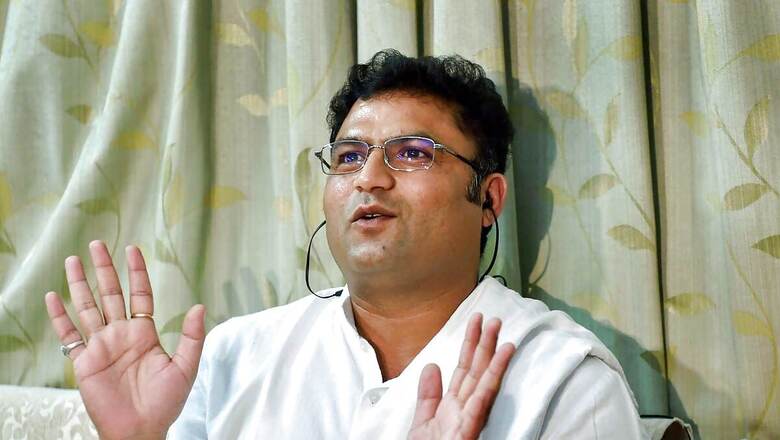
views
During this year’s Lok Sabha elections, the Bharatiya Janata Party (BJP) fielded 110 candidates, but only 41 of them emerged victorious. One of the turncoats fielded by the saffron party was Ashok Tanwar, a Dalit politician who was given a ticket from the Sirsa (SC) Lok Sabha constituency of Haryana, replacing the sitting party MP, Sunita Duggal. However, the BJP failed to retain the seat as Ashok Tanwar was defeated by Congress’s Selja Kumari, a prominent Dalit face in the state.
Recently, the same Ashok Tanwar rejoined the Congress in the presence of former party president Rahul Gandhi on the last day of the election campaign for the Haryana Assembly polls. Interestingly, he joined just hours after addressing an election rally for a BJP candidate. Five years ago, Tanwar, who was once the state Congress president, left the party and indirectly supported the Jananayak Janata Party of Dushyant Chautala during the state elections in 2019. He later formed his own party, Apna Bharat Morcha, but when he found that his political outfit failed to create any buzz, he joined the Trinamool Congress, which again failed to gain traction in the state.
Afterwards, he joined the Aam Aadmi Party (AAP), giving hope to Arvind Kejriwal’s party in the state. However, AAP too failed to emerge as a credible alternative. Then Tanwar turned towards the BJP, and now, after five years, he is back with his original party, Congress.
While Ashok Tanwar’s reputation as a known party hopper in the state may not come as a surprise to some, this episode calls for deep introspection within the saffron party, which granted him a Lok Sabha ticket just a few months after he joined. Tanwar’s case isn’t isolated.
In West Bengal, this year the party nominated sitting MP Arjun Singh from the Barrackpore Lok Sabha constituency. It is worth mentioning that he left the party after being elected to the Lok Sabha in 2019 to join the Trinamool Congress (TMC), returning only when he was denied a ticket by the TMC. Despite this, the saffron party did not hesitate to nominate him again from Barrackpore. However, the electors punished him, electing TMC’s Partha Bhowmick instead.
Recently, while interacting with BJP party workers and leaders in Navi Mumbai, Union Home Minister Amit Shah stated that the saffron party has a very “good digestion” and that anyone who joins will be assimilated. It is true that when a party grows—particularly one in power—it attracts many leaders from rival political parties. Not admitting these leaders, especially those with grassroots support and a positive public image, would be a political mistake.
However, since the BJP came to power at the Centre in 2014, it has been observed that the party leadership has accommodated many leaders from rival political parties, sometimes angering its own leaders and cadres. Some of these leaders, previously accused of corruption by the saffron party leadership, have tarnished the party’s image among the electorate. This was allegedly one of the reasons, supported even by the party’s ideological parent, the Rashtriya Swayamsevak Sangh (RSS), for the reduction of the BJP’s seats to 240 in this year’s Lok Sabha polls.
Ironically, the BJP’s image has taken a hit among the electorate and its cadres in Maharashtra, even as Amit Shah spoke about the party having a “very good digestion” regarding the accommodation of rival party leaders. The party’s troubles began when it decided to ally with the Ajit Pawar-led faction of the Nationalist Congress Party (NCP), despite already having a coalition with the Eknath Shinde-led faction of the Shiv Sena. While Shinde’s Sena shares ideological similarities with the BJP, the Ajit Pawar-led NCP faction is ideologically distinct and aligned with the BJP solely to share power. Notably, it was Ajit Pawar against whom BJP leaders had previously levelled corruption charges, yet he was later accommodated in the BJP-led National Democratic Alliance, referred to as Mahayuti in the state. This alliance is particularly controversial given that Ajit Pawar’s faction had abandoned it just five years ago, remaining for only two days.
If that weren’t enough, this year, former state chief minister Ashok Chavan, previously accused of corruption by the BJP, was inducted into the saffron party ahead of the Lok Sabha polls. Just days after joining, Chavan was nominated to the Rajya Sabha by the party.
Such actions by the BJP did not resonate well with the state electorate, who noted the saffron party’s flip-flops on corruption and ideology for the sake of power. Consequently, the National Democratic Alliance (NDA) performed poorly in Maharashtra, the second-largest state in terms of Lok Sabha seats. This disappointing performance was also attributed to the discontent among saffron cadres, who felt that the party was diluting its ideology to align with and accommodate leaders once targeted for corruption and lacking ideological similarities.
Recall that ahead of the West Bengal assembly polls in 2021, the BJP embarked on a recruitment drive, inducting many—if not all—of the ruling Trinamool Congress (TMC) leaders who wished to join the saffron party. It even offered tickets to several of these TMC leaders during the assembly elections, hoping they would help clinch power in this crucial eastern state. However, the decision to nominate many TMC leaders, some of whom faced allegations of corruption or had attacked Opposition supporters, backfired. This was particularly ironic given that the BJP had campaigned against the alleged misrule of the TMC government led by Mamata Banerjee. Interestingly, following the TMC’s victory, a significant number of these candidates left the BJP to rejoin the TMC, leaving the saffron party in a difficult position.
There was a time when the BJP took pride in being known as “a party with a difference.” Whether the saffron leadership acknowledges it or not, this carefully cultivated image has taken a hit in recent times due to the induction of many leaders who show little interest in pursuing the party’s Hindutva ideology. The BJP would be making a mistake if it viewed Ashok Tanwar’s case in isolation. It is high time for the saffron party to reconsider its approach to accommodating every rival political leader who wishes to join, many of whom lack genuine commitment to the party’s Hindutva ideals. These individuals often join the BJP primarily for the power it holds at the Centre and in more than a dozen states. Restoring the party’s diminished image among the electorate—and particularly among its cadres and supporters—requires a more discerning strategy.
Sagarneel Sinha is a political commentator and tweets @SagarneelSinha. Views expressed in the above piece are personal and solely that of the author. They do not necessarily reflect News18’s views.

















Comments
0 comment